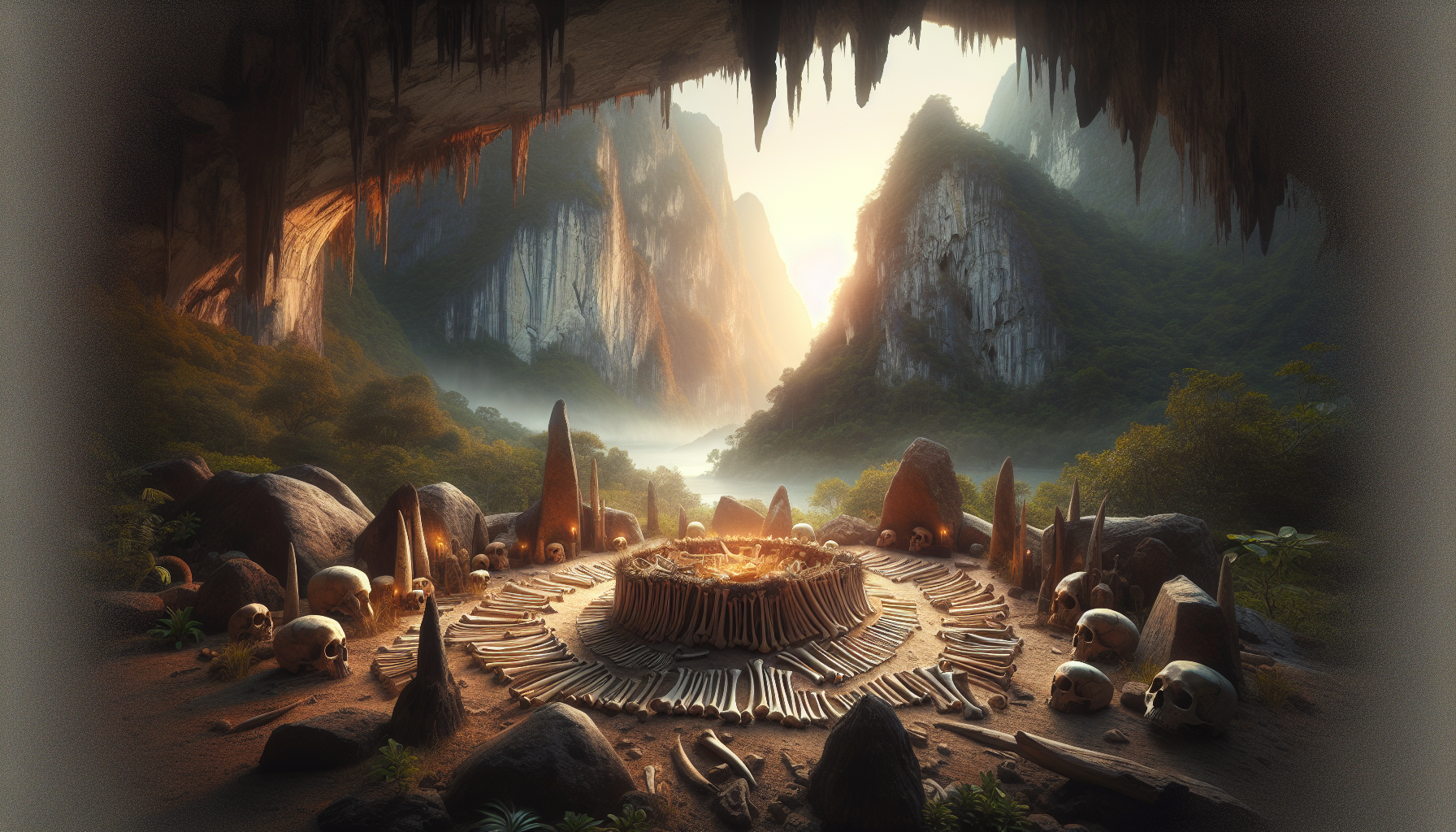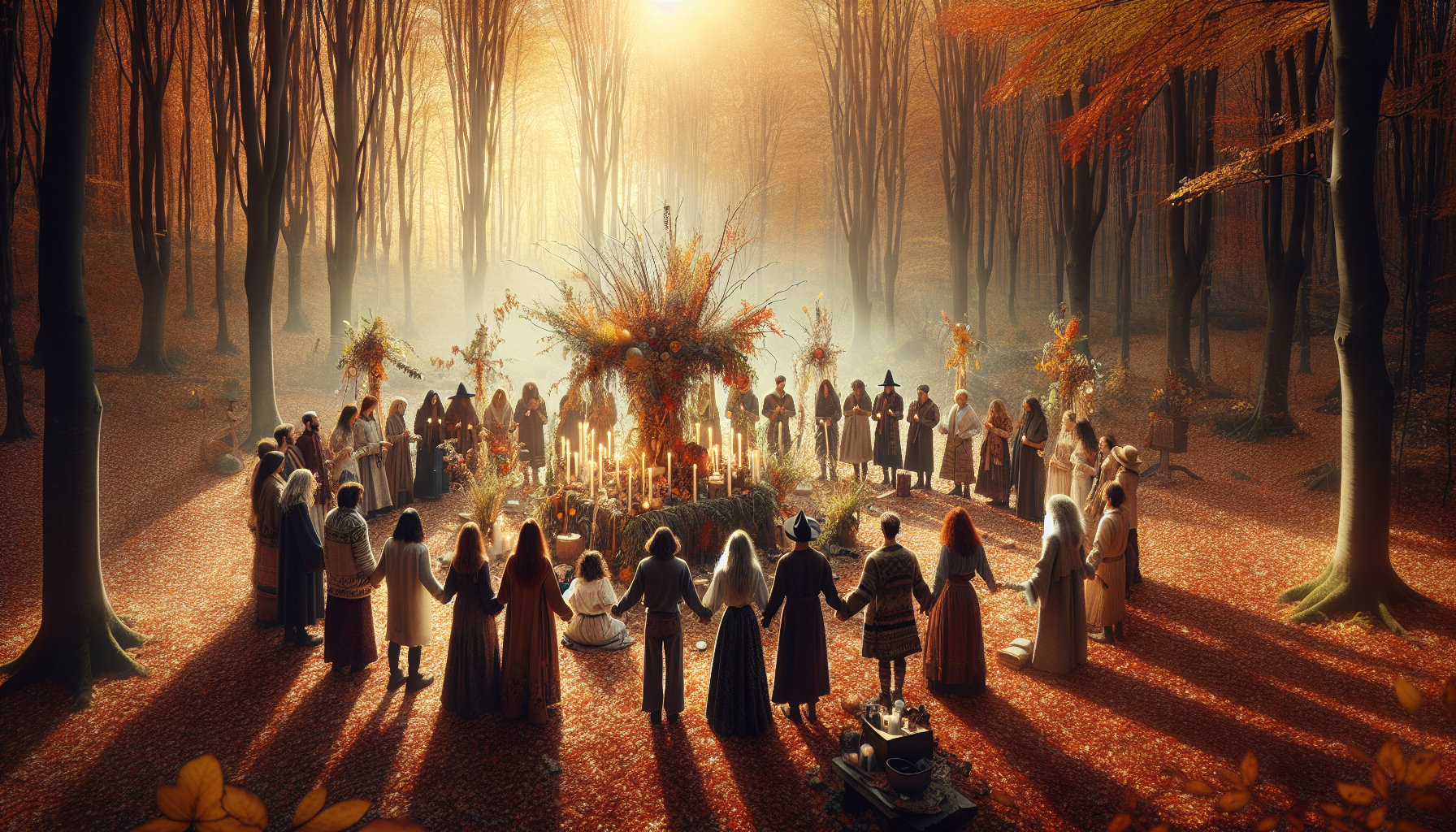In the heart of the world’s most majestic mountain ranges, where the earth’s crust has folded and heaved to form towering peaks, lie secrets as ancient as the stones themselves. These towering landscapes, often seen as barriers, have throughout history served as conduits of mystery and spirituality. Among these natural wonders, nestled within the hidden crevices and whispering winds, are enigmatic sites that have captured the imaginations of adventurers and scholars alike: the bone altars. These sacred spaces, shrouded in myth and enigma, beckon us to explore the rich tapestry of human history woven into the very fabric of these mountain passes. 🌄
Imagine standing at the edge of a narrow path, the chill of the mountain air biting at your cheeks, the silence of the peaks broken only by the occasional call of an eagle or the rustle of wind through sparse vegetation. Before you, an arrangement of bones, carefully curated and placed, speaks of rituals long forgotten, of spiritual journeys undertaken by peoples whose names may have faded from our records, but whose presence lingers in these altars. What drove them to these heights? What significance did these altars hold in their lives and beliefs? These are the questions that guide our exploration, as we seek to uncover the mysteries etched into these sacred sites.
In this article, we delve into the world of bone altars, exploring their origins and meanings across different cultures and time periods. Our journey will take us through the rugged terrain of the Andes, the mystical passes of the Himalayas, and the sacred landscapes of the European Alps. We will examine how these altars served not only as spiritual sites but also as markers of human migration, trade routes, and cultural exchange. Each bone, each arrangement, tells a story of the past, offering clues to the lives and beliefs of those who came before us.
We will also explore the scientific and archaeological efforts to study these altars, revealing the cutting-edge techniques used to date and analyze the remains. By combining traditional archaeological methods with modern technology, researchers are piecing together the puzzle of these sacred sites, uncovering new insights into the cultures that created them. Through interviews with experts and firsthand accounts from those who have ventured to these remote locations, we aim to bring you a comprehensive understanding of the significance of bone altars in human history.
Join us as we embark on this fascinating journey, a trek through time and space that promises to enrich our understanding of humanity’s spiritual heritage. Whether you are a seasoned explorer, a history enthusiast, or simply curious about the mysteries of the past, this exploration of bone altars in mountain passes will offer a compelling glimpse into the enduring relationship between humans and the mountains they revere. 🏔️ Let the adventure begin.
The Historical Significance of Bone Altars in Mountain Passes
Bone altars have long intrigued historians, archaeologists, and spiritual enthusiasts alike. These mysterious structures, often found in remote mountain passes, carry with them a wealth of cultural, spiritual, and historical significance. The presence of these altars in such isolated locations has led to numerous theories regarding their purpose and the people who constructed them. This section delves into the history behind these altars, exploring their significance across different cultures and time periods.
The earliest records of bone altars date back to ancient civilizations, where they were often used as sites for spiritual and religious ceremonies. The choice of mountain passes for these altars was not random. Mountains have historically been considered sacred in many cultures, often seen as closer to the heavens and the divine. This spiritual symbolism, combined with the isolation and tranquility of mountain passes, made them ideal locations for religious observances. In many cultures, altars were used to communicate with gods, offer sacrifices, and conduct rituals aimed at ensuring successful hunts, harvests, or safe passage through the mountains.
Several ancient cultures, including the Celts, the Norse, and indigenous tribes in the Americas, are known to have built such altars. The materials used for construction varied, but bones were a common choice due to their spiritual symbolism and the relative ease with which they could be obtained. Bones were believed to hold the life force of the creatures they belonged to, making them potent offerings to the gods. In some cultures, human bones were used, possibly as a form of ancestor worship or as a way to honor the deceased.
Table of Ancient Cultures and Their Use of Bone Altars
| Culture | Geographical Region | Purpose of Altars |
|---|---|---|
| Celtic | Europe | Religious ceremonies and sacrifices |
| Norse | Scandinavia | Offerings to gods for protection and prosperity |
| Indigenous Tribes | Americas | Rituals to honor ancestors and ensure safe passage |
The table above illustrates the diverse use of bone altars across various ancient cultures. These sites were integral to the spiritual lives of the people, serving as a connection between the earthly and the divine. Understanding these historical contexts helps us appreciate the cultural richness and depth of these sacred sites.
The Spiritual and Symbolic Meanings Behind Bone Altars
The spiritual and symbolic meanings attributed to bone altars are deeply rooted in the belief systems of the cultures that created them. These altars were not merely physical structures but were imbued with profound spiritual significance. To the people of these ancient cultures, bone altars represented a tangible connection to the spiritual realm, serving as conduits for communication with the divine.
In many cultures, bones were seen as symbols of life and death, embodying the cyclical nature of existence. This dual symbolism made bones particularly powerful in ritual contexts. By offering bones at altars, worshipers believed they could gain favor from the gods or ancestors, ensuring blessings such as good health, fertility, and protection from harm. This practice underscores the deep reverence these cultures had for the natural world and their belief in the interconnectedness of all life.
The location of these altars also contributed to their spiritual significance. Mountain passes, with their remote and often challenging terrain, were seen as liminal spaces—places that exist between worlds. In spiritual terms, they were considered gateways to the divine, where the veil between the earthly and spiritual realms was thinnest. This belief further enhanced the power of rituals performed at bone altars, making them pivotal in the spiritual practices of these cultures.
Video: Exploring Sacred Sites in Mountain Passes
For a deeper understanding of the spiritual significance of these sites, watch the video below. It provides a captivating exploration of sacred sites located in mountain passes, highlighting their historical and spiritual importance.
Sacred Sites: Mountain Pass Altars – Channel: Ancient Mysteries Uncovered
Modern-Day Discoveries and Interpretations of Bone Altars
In recent years, the discovery and study of bone altars have gained significant attention from archaeologists and researchers worldwide. Modern technology, such as advanced dating methods and 3D mapping, has allowed for more accurate analysis of these sites, leading to new insights and interpretations. These discoveries are shedding light on the complexities of ancient societies and their spiritual practices.
One of the most intriguing aspects of modern research is the ability to analyze the composition of bone altars. By studying the types of bones used and their arrangement, researchers can gain insights into the rituals performed and the cultural significance of the altars. For instance, the presence of animal bones can indicate offerings made for successful hunts, while human bones might suggest ancestral worship or burial rites.
The study of bone altars is not just about understanding the past; it also has implications for modern spirituality and cultural heritage. Many of these sites are considered sacred by contemporary indigenous groups, and efforts are being made to preserve them. Understanding the historical context and spiritual significance of these altars is crucial for their protection and the continuation of cultural traditions.
Table: Modern Discoveries in Bone Altar Research
| Discovery | Location | Significance |
|---|---|---|
| Advanced Dating Methods | Global | Provides accurate dating of altars, revealing historical timelines |
| 3D Mapping Technology | Europe | Allows for detailed analysis and preservation of altar sites |
| Cultural Heritage Studies | Americas | Highlights the ongoing spiritual significance of altars for indigenous groups |
The ongoing research into bone altars continues to uncover fascinating insights into the beliefs and practices of ancient cultures. These discoveries not only enhance our understanding of history but also contribute to the preservation and appreciation of cultural heritage. As we continue to explore these sacred sites, we gain a deeper appreciation for the rich tapestry of human spirituality and the enduring legacy of our ancestors.
- Explore further into ancient spiritual practices through documentaries and scholarly articles.
- Visit local museums or heritage sites to learn more about bone altars and their significance.
- Engage with online forums or communities interested in archaeology and ancient history to share insights and discoveries.
These actions can deepen your understanding and appreciation of the mysteries surrounding bone altars and their enduring spiritual legacy. 🏔️✨

Conclusion
In conclusion, the exploration of bone altars in mountain passes unveils a fascinating intersection of archaeology, anthropology, and spirituality. Throughout our journey into these sacred sites, we have discovered that these altars, often shrouded in mystery, offer a unique glimpse into the rituals and beliefs of ancient cultures. The evidence suggests that these sites served not only as religious focal points but also as vital markers in the challenging terrains of mountain passes. This dual purpose underscores the significance of bone altars in understanding the complex relationship between humans and their environment.
We have delved into the historical context of these altars, examining their construction and the cultural implications they bear. By analyzing various archaeological findings, it becomes evident that these sites were meticulously chosen and crafted, reflecting a deep-seated reverence for the natural world and the spiritual realm. The presence of animal bones and other offerings indicates a ritualistic practice aimed at appeasing deities, seeking protection, or marking significant territorial boundaries. Such practices highlight the ingenuity and adaptability of ancient societies in navigating both physical and metaphysical landscapes.
The role of mountain passes as strategic locations cannot be understated. As gateways between regions, these passes were critical for trade, migration, and communication. The placement of bone altars in these areas suggests a deliberate attempt to harness the spiritual energy believed to be inherent in such liminal spaces. By situating altars at these junctions, ancient peoples could invoke divine guidance and ensure safe passage through treacherous terrains. This strategic positioning not only facilitated physical journeys but also symbolized the crossing between worlds—the known and the unknown, the material and the spiritual.
Moreover, the study of bone altars invites us to reflect on the broader human experience. These sites remind us of the universal quest for meaning and the enduring human tendency to connect with something greater than ourselves. They serve as poignant reminders of our ancestors’ resilience and creativity in the face of adversity, offering valuable lessons for contemporary society. As we confront modern challenges, the ancient wisdom encapsulated in these altars can inspire us to seek harmony with our environment and embrace the interconnectedness of all life.
The importance of preserving and studying these sacred sites cannot be overstated. As modern development encroaches on these historical landscapes, it is crucial to prioritize conservation efforts and promote public awareness of their cultural and spiritual value. By safeguarding these sites, we honor the legacy of those who came before us and ensure that future generations can continue to learn from and be inspired by their rich heritage.
In light of these insights, I encourage you, dear reader, to reflect on the themes discussed and consider their relevance in your own life. Whether it be through academic exploration, personal reflection, or community engagement, there are myriad ways to connect with the mysteries of bone altars. Share your thoughts and insights with others, foster discussions that deepen our collective understanding, and perhaps even embark on your own journey to visit these awe-inspiring sites.
For those interested in further exploration, I recommend checking out reputable sources that offer more in-depth analyses and photographs of these intriguing altars. Consider visiting Archaeology Magazine and National Geographic, which provide valuable resources and up-to-date research on similar topics.
Ultimately, the study of bone altars in mountain passes is a testament to the enduring human spirit and our perpetual quest to uncover the mysteries of our past. As we continue to unravel these enigmas, let us do so with a sense of wonder and reverence for the rich tapestry of human history that connects us all. 🌄✨
Toni Santos is a visual storyteller and symbolic naturalist whose creations explore the hidden ecologies and forgotten bonds between humans and nature, as whispered through ancient lore. Through an intuitive and myth-sensitive lens, Toni reveals the sacred choreography between flora, fauna, and human spirit — a world where trees once spoke, rivers remembered, and every herb carried a secret name.
His journey is rooted in the esoteric — in the rituals of forest-dwellers, the botanical codes of shamans, and the unspoken pacts that shaped how ancient peoples lived in deep, reciprocal harmony with the natural world. From sacred groves to serpent-guarded springs, each of Toni’s works reflects a symbolic relationship long obscured by modern forgetfulness.
With a background in visual design and ancestral aesthetics, Toni merges storytelling with sacred ecology. His pieces don’t simply illustrate — they channel. Drawing from myth, mysticism, and lost herbal traditions, he crafts visuals that resonate with the old wisdom: that nature is not background, but kin.
As the creative spirit behind Vizovex, Toni shares collections, visual studies, and articles that illuminate the occulted connections between human life and the wild world. His work calls on us to remember — not just with the mind, but with the senses and the soul — the profound dialogues our ancestors once had with earth, plant, and animal.
His work is a tribute to:
The mythic language of trees, stones, and roots
Forgotten pacts between healers and the wilderness
The sacred knowledge carried in nature’s unseen patterns
Whether you’re a seeker of ancient plant-lore, a mystic attuned to seasonal cycles, or simply someone who hears the forest speak, Toni welcomes you to wander a space where symbolism, nature, and spirit entwine — one myth, one leaf, one vision at a time.





